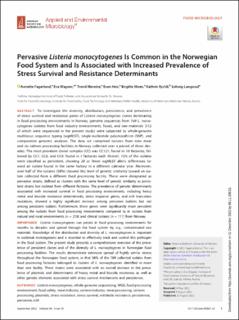| dc.contributor.author | Fagerlund, Annette | |
| dc.contributor.author | Wagner, Eva | |
| dc.contributor.author | Møretrø, Trond | |
| dc.contributor.author | Heir, Even | |
| dc.contributor.author | Moen, Birgitte | |
| dc.contributor.author | Rychli, Kathrin | |
| dc.contributor.author | Langsrud, Solveig | |
| dc.date.accessioned | 2022-12-05T08:39:51Z | |
| dc.date.available | 2022-12-05T08:39:51Z | |
| dc.date.created | 2022-09-06T15:28:12Z | |
| dc.date.issued | 2022 | |
| dc.identifier.citation | Applied and Environmental Microbiology. 2022, 88 (18), . | |
| dc.identifier.issn | 0099-2240 | |
| dc.identifier.uri | https://hdl.handle.net/11250/3035768 | |
| dc.description.abstract | To investigate the diversity, distribution, persistence, and prevalence of stress survival and resistance genes of Listeria monocytogenes clones dominating in food processing environments in Norway, genome sequences from 769 L. monocytogenes isolates from food industry environments, foods, and raw materials (512 of which were sequenced in the present study) were subjected to whole-genome multilocus sequence typing (wgMLST), single-nucleotide polymorphism (SNP), and comparative genomic analyses. The data set comprised isolates from nine meat and six salmon processing facilities in Norway collected over a period of three decades. The most prevalent clonal complex (CC) was CC121, found in 10 factories, followed by CC7, CC8, and CC9, found in 7 factories each. Overall, 72% of the isolates were classified as persistent, showing 20 or fewer wgMLST allelic differences toward an isolate found in the same factory in a different calendar year. Moreover, over half of the isolates (56%) showed this level of genetic similarity toward an isolate collected from a different food processing facility. These were designated as pervasive strains, defined as clusters with the same level of genetic similarity as persistent strains but isolated from different factories. The prevalence of genetic determinants associated with increased survival in food processing environments, including heavy metal and biocide resistance determinants, stress response genes, and inlA truncation mutations, showed a highly significant increase among pervasive isolates but not among persistent isolates. Furthermore, these genes were significantly more prevalent among the isolates from food processing environments compared to in isolates from natural and rural environments (n = 218) and clinical isolates (n = 111) from Norway | |
| dc.language.iso | eng | |
| dc.relation.uri | https://journals.asm.org/doi/epub/10.1128/aem.00861-22 | |
| dc.subject | Food safety | |
| dc.subject | Food safety | |
| dc.subject | WGS | |
| dc.subject | WGS | |
| dc.subject | Whole genome sequencing | |
| dc.subject | Whole genome sequencing | |
| dc.subject | Listeria monocytogenes | |
| dc.subject | Listeria monocytogenes | |
| dc.subject | Food processing environment | |
| dc.subject | Food processing environment | |
| dc.title | Pervasive Listeria monocytogenes Is Common in the Norwegian Food System and Is Associated with Increased Prevalence of Stress Survival and Resistance Determinants | |
| dc.title.alternative | Pervasive Listeria monocytogenes Is Common in the Norwegian Food System and Is Associated with Increased Prevalence of Stress Survival and Resistance Determinants | |
| dc.title.alternative | Pervasive Listeria monocytogenes is common in the Norwegian food system and is associated with increased prevalence of stress survival and resistance determinants | |
| dc.type | Peer reviewed | |
| dc.type | Journal article | |
| dc.description.version | publishedVersion | |
| dc.source.pagenumber | 21 | |
| dc.source.volume | 88 | |
| dc.source.journal | Applied and Environmental Microbiology | |
| dc.source.issue | 18 | |
| dc.identifier.doi | 10.1128/aem.00861-22 | |
| dc.identifier.cristin | 2049252 | |
| dc.relation.project | Norges forskningsråd: 314743 | |
| dc.relation.project | Norges forskningsråd: 294910 | |
| dc.relation.project | Nofima AS: 12635 | |
| dc.relation.project | Nofima AS: 202104 | |
| cristin.ispublished | true | |
| cristin.fulltext | original | |
| cristin.qualitycode | 2 | |
